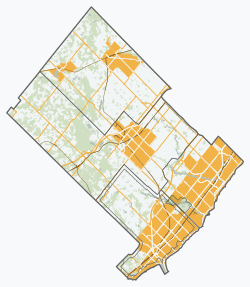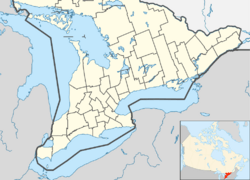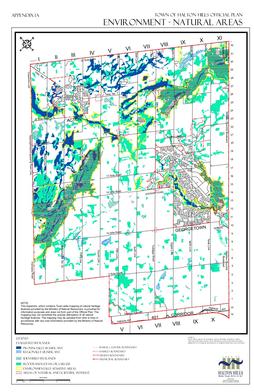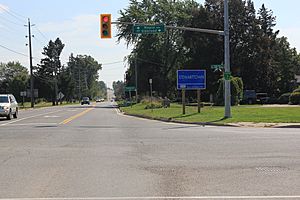Halton Hills facts for kids
Quick facts for kids
Halton Hills
|
|||
|---|---|---|---|
| Town of Halton Hills | |||
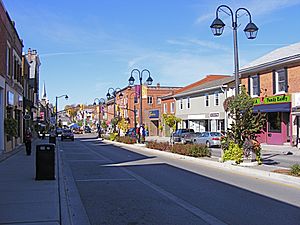
Main Street, Georgetown
|
|||
|
|||
| Motto(s):
Hereditas Integritas Veritas (Latin: Heritage, integrity, truth)
|
|||
| Country | Canada | ||
| Province | Ontario | ||
| Region | Halton | ||
| Incorporated | 1974 | ||
| Area | |||
| • Land | 276.26 km2 (106.66 sq mi) | ||
| • Urban | 39.52 km2 (15.26 sq mi) | ||
| • Rural | 236.74 km2 (91.41 sq mi) | ||
| Highest elevation | 411 m (1,348 ft) | ||
| Lowest elevation | 197 m (646 ft) | ||
| Population
(2016)
|
|||
| • Town (lower-tier) | 61,161 | ||
| • Density | 221.4/km2 (573/sq mi) | ||
| • Urban | 49,854 | ||
| • Urban density | 1,261.49/km2 (3,267.2/sq mi) | ||
| • Rural | 9,154 | ||
| • Rural density | 38.6669/km2 (100.147/sq mi) | ||
| Time zone | UTC−05:00 (EST) | ||
| • Summer (DST) | UTC−04:00 (EDT) | ||
| Area code(s) | 905, 289, and 365 | ||
| NTS Map | 30M12 Brampton | ||
| GNBC Code | FBLIE | ||
Halton Hills is a town in Ontario, Canada. It's part of the Halton Region, located northwest of the big city area called the Greater Toronto Area. In 2021, about 62,951 people lived here.
The town has many cool natural spots. These include the Niagara Escarpment and the Bruce Trail, which is a long hiking path. Many of these natural areas are protected by groups like Conservation Halton.
Contents
Towns and Villages in Halton Hills
Halton Hills is made up of several communities. The two main population centers are Georgetown and Acton.
Besides these, there are many smaller villages and rural areas. Some of these include Glen Williams, Limehouse, and Norval. People first started settling in this area around the 1820s.
Exploring Halton Hills' Geography
The town is split in half by the Niagara Escarpment, which runs from the southwest to the northeast. A large part of the countryside is protected as a provincial Greenbelt.
Above the Escarpment, much of the land is made of important wetlands. There are also places where rocks and gravel are dug up. Below the Escarpment, the land is mostly used for farming.
The town is also part of three different watersheds:
- To the west of Acton, a small area drains into the Grand River.
- The northern half drains into the Credit River, including smaller streams like Black Creek.
- The southern half drains into the Sixteen Mile Creek.
Canada's Water Survey has stations in Halton Hills. They measure the water levels in Black Creek and the Credit River.
Plants and Trees in Halton Hills
Halton Hills is a special place for plants. It's where two different forest types meet. To the north, you find mixed forests with both leafy and cone-bearing trees. To the south, there are forests mostly with broad-leaved trees.
Overall, Halton Hills has a lot of farms, but also many scattered woodlands and wetlands. The woodlands are mainly forests with trees that lose their leaves in the fall. The wetlands are often swamps with cedar trees or marshes with cattail plants.
Animals and Plants Needing Protection
Some special plants and animals live in Halton Hills and need our help.
- American ginseng is a plant protected by law.
- Butternut trees are also in danger from a disease called butternut canker.
- The hooded warbler (a bird) and the Jefferson salamander are also considered threatened species.
Years ago, Brook trout disappeared from Black Creek. But now, they have returned, and people can enjoy fishing for them again!
The Rocks and Land of Halton Hills
The landscape of Halton Hills was shaped by glaciers. These huge ice sheets moved across the land about 10,000 to 23,000 years ago.
The Niagara Escarpment is the most important natural feature. It's a high rock cliff formed over millions of years by erosion. West of the Escarpment, you can see hilly ridges left behind by the glaciers. To the southeast, below the Escarpment, the land is flatter.
Underneath Halton Hills, there are different types of rocks. East of the Escarpment, you'll find shale rock. West of it, there's dolostone. The Escarpment itself shows many layers of different rocks like shale, sandstone, and limestone.
People have been quarrying (digging up) limestone here since the 1800s. The lime industry was once very important. In 1886, companies here made lime for building and even mineral paints.
Small amounts of oil and gas have been found near Acton and Hornby. While oil was first found in 1912, bigger discoveries happened in 1954.
The area doesn't have many big earthquakes. The largest recent one was a small magnitude 3 earthquake in 1955. There's a special station near Acton that monitors earthquakes.
Halton Hills' Weather
Halton Hills has a humid continental climate. This means it has warm summers and cold winters.
The town has two slightly different climate zones:
- Zone 5a: North of the Niagara Escarpment.
- Zone 5b: South of the Escarpment.
| Climate data for Georgetown WWTP (Halton Hills), 1981−2010 | |||||||||||||
|---|---|---|---|---|---|---|---|---|---|---|---|---|---|
| Month | Jan | Feb | Mar | Apr | May | Jun | Jul | Aug | Sep | Oct | Nov | Dec | Year |
| Record high °C (°F) | 17.0 (62.6) |
15.5 (59.9) |
25.0 (77.0) |
31.5 (88.7) |
34.5 (94.1) |
36.0 (96.8) |
37.0 (98.6) |
36.5 (97.7) |
35.5 (95.9) |
29.5 (85.1) |
22.0 (71.6) |
20.5 (68.9) |
37.0 (98.6) |
| Mean daily maximum °C (°F) | −1.7 (28.9) |
−0.2 (31.6) |
4.6 (40.3) |
12.1 (53.8) |
19.1 (66.4) |
24.4 (75.9) |
26.9 (80.4) |
25.8 (78.4) |
21.4 (70.5) |
14.3 (57.7) |
7.3 (45.1) |
1.1 (34.0) |
12.9 (55.2) |
| Daily mean °C (°F) | −6.3 (20.7) |
−5.2 (22.6) |
−0.9 (30.4) |
6.0 (42.8) |
12.3 (54.1) |
17.4 (63.3) |
20.0 (68.0) |
19.0 (66.2) |
14.8 (58.6) |
8.4 (47.1) |
2.8 (37.0) |
−2.9 (26.8) |
7.1 (44.8) |
| Mean daily minimum °C (°F) | −10.9 (12.4) |
−10.2 (13.6) |
−6.4 (20.5) |
−0.2 (31.6) |
5.3 (41.5) |
10.4 (50.7) |
13.0 (55.4) |
12.1 (53.8) |
8.1 (46.6) |
2.4 (36.3) |
−1.7 (28.9) |
−6.9 (19.6) |
1.3 (34.3) |
| Record low °C (°F) | −33.0 (−27.4) |
−31.5 (−24.7) |
−28.0 (−18.4) |
−13.0 (8.6) |
−5.0 (23.0) |
−0.5 (31.1) |
3.0 (37.4) |
0.0 (32.0) |
−4.0 (24.8) |
−8.5 (16.7) |
−15.5 (4.1) |
−29.5 (−21.1) |
−33.0 (−27.4) |
| Average precipitation mm (inches) | 67.8 (2.67) |
60.0 (2.36) |
57.2 (2.25) |
76.5 (3.01) |
79.3 (3.12) |
74.8 (2.94) |
73.5 (2.89) |
79.3 (3.12) |
86.2 (3.39) |
68.3 (2.69) |
88.5 (3.48) |
65.9 (2.59) |
877.4 (34.54) |
| Average rainfall mm (inches) | 29.7 (1.17) |
28.4 (1.12) |
35.2 (1.39) |
71.3 (2.81) |
79.0 (3.11) |
74.8 (2.94) |
73.5 (2.89) |
79.3 (3.12) |
86.2 (3.39) |
67.8 (2.67) |
79.9 (3.15) |
36.4 (1.43) |
741.5 (29.19) |
| Average snowfall cm (inches) | 38.1 (15.0) |
31.7 (12.5) |
22.1 (8.7) |
5.2 (2.0) |
0.3 (0.1) |
0.0 (0.0) |
0.0 (0.0) |
0.0 (0.0) |
0.0 (0.0) |
0.5 (0.2) |
8.6 (3.4) |
29.5 (11.6) |
135.9 (53.5) |
| Average precipitation days (≥ 0.2 mm) | 12.6 | 9.4 | 10.6 | 12.4 | 11.9 | 11.2 | 10.6 | 10.6 | 11.7 | 12.3 | 13.3 | 12.3 | 138.9 |
| Average rainy days (≥ 0.2 mm) | 4.1 | 4.1 | 6.4 | 11.6 | 11.8 | 11.2 | 10.6 | 10.6 | 11.7 | 12.2 | 11.4 | 6.5 | 112.1 |
| Average snowy days (≥ 0.2 cm) | 9.4 | 6.2 | 4.8 | 1.4 | 0.04 | 0.0 | 0.0 | 0.0 | 0.0 | 0.27 | 2.5 | 6.9 | 31.5 |
| Source: Environment Canada | |||||||||||||
A Look at Halton Hills' History
Halton Hills was created in 1974. This happened when the towns of Georgetown and Acton joined together. Parts of other areas, like Esquesing and Oakville, also became part of the new town.
On August 1, 2013, a large shopping center called Toronto Premium Outlets opened in Halton Hills. It was the first of its kind in Canada.
Who Lives in Halton Hills?
| Halton Hills | ||
|---|---|---|
| Year | Pop. | ±% |
| 1981 | 35,190 | — |
| 1991 | 36,816 | +4.6% |
| 1996 | 42,390 | +15.1% |
| 2001 | 48,184 | +13.7% |
| 2006 | 55,289 | +14.7% |
| 2011 | 59,008 | +6.7% |
| 2016 | 61,161 | +3.6% |
| 2021 | 62,951 | +2.9% |
| Canada census – Halton Hills community profile | |||
|---|---|---|---|
| 2016 | 2011 | 2006 | |
| Population: | 61,161 (3.6% from 2011) | 59,008 (6.7% from 2006) | 55,289 (14.7% from 2001) |
| Land area: | 276.27 km2 (106.67 sq mi) | 276.25 km2 (106.66 sq mi) | 276.26 km2 (106.66 sq mi) |
| Population density: | 221.4/km2 (573/sq mi) | 213.6/km2 (553/sq mi) | 200.1/km2 (518/sq mi) |
| Median age: | 41.3 (M: 40.5, F: 42.0) | 39.9 (M: 39.3, F: 40.4) | 37.9 (M: 37.5, F: 38.2) |
| Total private dwellings: | 21,080 | 20,548 | 19,265 |
| Median household income: | $106,349 | $94,190 | $85,520 |
| References: 2016 2011 2006 earlier | |||
In 2021, most people in Halton Hills were of European background (84.6%). About 13.6% were from visible minority groups, and 1.8% were Indigenous. The largest visible minority groups were South Asian, Black, and Chinese.
Most residents (80.8%) speak English as their first language. Other common first languages include Polish, Portuguese, and French.
Many people in Halton Hills are Christian (61.4%). This includes Catholics and Protestants. About 32.2% of people said they were not religious. Other religions like Islam, Sikhism, and Hinduism are also present.
Getting Around Halton Hills: Transportation
The town has four main roads that help people travel:
East-West Roads
 Highway 7: Connects Acton and Georgetown.
Highway 7: Connects Acton and Georgetown.- Regional Road 8 (Steeles Avenue): Runs between Milton and Brampton.
North-South Roads
- Regional Road 25: Connects Acton and Milton.
- Regional Road 3 (Trafalgar Road): Runs between Ballinafad and Oakville.
You can also travel by bus with GO Transit along Highway 7. Train services are available at the Georgetown GO Station.
Trains first came to the area in 1856. Passenger train service to Acton stopped in the 1990s, but it's planned to start again. Freight trains also use the tracks through Halton Hills.
Learning in Halton Hills: Schools
Halton Hills has many schools for students. They are part of two main school boards: the Halton District School Board (public schools) and the Halton Catholic District School Board (Catholic schools). There are also some independent schools.
| Type | Halton District School Board | Halton Catholic District School Board | Independent |
|---|---|---|---|
| Secondary school |
|
|
|
| Primary school |
|
|
|
News and Media in Halton Hills
If you want to know what's happening in Halton Hills, you can check out HaltonHillsToday.ca. It's an online source for local news, weather, sports, and more.
There are also several local newspapers and online news sites:
- Georgetown Independent
- Acton Free Press
- The Acton New Tanner
- The Halton Compass
- Halton Herald
- In Georgetown Community Website
A radio tower in Hornby helps broadcast signals for radio stations CFZM and CJBC.
Halton Hills' Sister City
Halton Hills has one sister city, which means they have a special friendly relationship:
- Wenjiang (Chengdu), in Sichuan, China.




